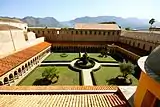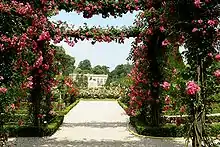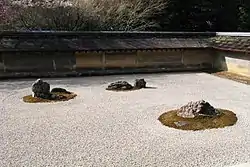Garden
A garden is a planned space, usually outdoors, set aside for the display, cultivation, or enjoyment of plants and other forms of nature, as an ideal setting for social or solitary human life. The single feature identifying even the wildest wild garden is control. The garden can incorporate both natural and man-made materials.

Gardens often have design features including statuary, follies, pergolas, trellises, stumperies, dry creek beds and water features such as fountains, ponds (with or without fish), waterfalls or creeks. Some gardens are for ornamental purposes only, while others also produce food crops, sometimes in separate areas, or sometimes intermixed with the ornamental plants. Food-producing gardens are distinguished from farms by their smaller scale, more labor-intensive methods, and their purpose (enjoyment of a hobby or self-sustenance rather than producing for sale, as in a market garden). Flower gardens combine plants of different heights, colors, textures, and fragrances to create interest and delight the senses.
Landscape architecture is a related professional activity with landscape architects tending to engage in design at many scales and working on both public and private projects.
The most common form today is a residential or public garden, but the term garden has traditionally been a more general one. Zoos, which display wild animals in simulated natural habitats, were formerly called zoological gardens.[1][2] Western gardens are almost universally based on plants, with garden, which etymologically implies enclosure, often signifying a shortened form of botanical garden. Some traditional types of eastern gardens, such as Zen gardens, however, use plants sparsely or not at all. Landscape gardens, on the other hand, such as the English landscape gardens first developed in the 18th century, may omit flowers altogether.
Background
The culture of gardening reaches deep into antiquity, when Alexander the Great was reportedly awestruck by the magnificence of Babylon's gardens. Homer tells of the Garden of Alcinous, its fertility and symmetry of form.
The Romans were known for planting their gardens with the riches of Asia.[3]
Gardening was not recognized as an art form in Europe until the mid 16th century when it entered the political discourse, as a symbol of the concept of the "ideal republic". Evoking utopian imagery of the Garden of Eden, a time of abundance and plenty where humans didn't know hunger or the conflicts that arose from property disputes. John Evelyn wrote in the early 17th century, "there is not a more laborious life then is that of a good Gard'ners; but a labour full of tranquility and satisfaction; Natural and Instructive, and such as (if any) contributes to Piety and Contemplation".[4] During the era of Enclosures, the agrarian collectivism of the feudal age was idealized in literary "fantasies of liberating regression to garden and wilderness".[5]
Before the Grand Manner era what few significant gardens could be found in Britain had developed under influence from the continent. Britain's homegrown domestic gardening traditions were mostly practical in purpose, rather than aesthetic, unlike the grand gardens found mostly on castle grounds, and less commonly at universities. Tudor gardens emphasized contrast rather than transitions, distinguished by color and illusion. They were not intended as a complement to home or architecture, but conceived as independent spaces, arranged to grow and display flowers and ornamental plants. Gardeners demonstrated their artistry in knot gardens, with complex arrangements most commonly included interwoven box hedges, and less commonly fragrant herbs like rosemary. Sanded paths run between the hedgings of open knots whereas closed knots were filled with single colored flowers. The knot and parterre gardens were always placed on level ground, and elevated areas reserved for terraces from which the intricacy of the gardens could be viewed.[6]
Jacobean gardens were described as "a delightful confusion" by Henry Wotton in 1624. Under the influence of the Italian Renaissance, Caroline gardens began to shed some of the chaos of earlier designs, marking the beginning of a trends towards symmetrical unified designs that took the building architecture into account, and featuring an elevated terrace from which home and garden could be viewed. The only surviving Caroline garden is located at Bolsover Castle in Derbyshire, but is too simple to attract much interest.[6]
by the mid-17th century axial symmetry had ascended to prominence in the French gardening traditions of Andre Mollet and Jacques Boyceau, the latter who wrote: "All things, however beautiful they may be chosen, will be defective if they are not ordered and placed in proper symmetry." During the reign of Charles II, many new Baroque style country houses were built, while in England Thomas Cromwell sought to destroy many Tudor, Jacobean and Caroline style gardens.[6]
Etymology
The etymology of the word gardening refers to enclosure: it is from Middle English gardin, from Anglo-French gardin, jardin, of Germanic origin; akin to Old High German gard, gart, an enclosure or compound, as in Stuttgart. See Grad (Slavic settlement) for more complete etymology.[7] The words yard, court, and Latin hortus (meaning "garden," hence horticulture and orchard), are cognates—all referring to an enclosed space.[8]
The term "garden" in British English refers to a small enclosed area of land, usually adjoining a building.[9] This would be referred to as a yard in American English.
Design

Garden design is the process of creating plans for the layout and planting of gardens and landscapes. Gardens may be designed by garden owners themselves, or by professionals. Professional garden designers tend to be trained in principles of design and horticulture, and have a knowledge and experience of using plants. Some professional garden designers are also landscape architects, a more formal level of training that usually requires an advanced degree and often a state license.
Elements of garden design include the layout of hard landscape, such as paths, rockeries, walls, water features, sitting areas and decking, as well as the plants themselves, with consideration for their horticultural requirements, their season-to-season appearance, lifespan, growth habit, size, speed of growth, and combinations with other plants and landscape features. Most gardens consist of a mix of natural and constructed elements, although even very 'natural' gardens are always an inherently artificial creation. Natural elements present in a garden principally comprise flora (such as trees and weeds), fauna (such as arthropods and birds), soil, water, air and light. Constructed elements include paths, patios, decking, sculptures, drainage systems, lights and buildings (such as sheds, gazebos, pergolas and follies), but also living constructions such as flower beds, ponds and lawns.
Consideration is also given to the maintenance needs of the garden. Including the time or funds available for regular maintenance, (this can affect the choices of plants regarding speed of growth) spreading or self-seeding of the plants(annual or perennial), bloom-time, and many other characteristics. Garden design can be roughly divided into two groups, formal and naturalistic gardens. The most important consideration in any garden design is how the garden will be used, followed closely by the desired stylistic genres, and the way the garden space will connect to the home or other structures in the surrounding areas. All of these considerations are subject to the limitations of the budget. Budget limitations can be addressed by a simpler garden style with fewer plants and less costly hard landscape materials, seeds rather than sod for lawns, and plants that grow quickly; alternatively, garden owners may choose to create their garden over time, area by area.[10]

 Royal gardens of Reggia di Caserta, Italy
Royal gardens of Reggia di Caserta, Italy
 Example of a garden attached to a place of worship: the cloister of the Abbey of Monreale, Sicily, Italy
Example of a garden attached to a place of worship: the cloister of the Abbey of Monreale, Sicily, Italy The Sunken Garden of Butchart Gardens, Victoria, British Columbia
The Sunken Garden of Butchart Gardens, Victoria, British Columbia

 Garden with fountains, Villa d'Este, Italy
Garden with fountains, Villa d'Este, Italy.jpg.webp) Gardens at Colonial Williamsburg, Williamsburg, Virginia, feature many heirloom varieties of plants.
Gardens at Colonial Williamsburg, Williamsburg, Virginia, feature many heirloom varieties of plants.
Uses

A garden can have aesthetic, functional, and recreational uses:
- Cooperation with nature
- Observation of nature
- Relaxation
- Growing useful produce
- Flowers to cut and bring inside for indoor beauty
- Fresh herbs and vegetables for cooking
Types




Gardens may feature a particular plant or plant type(s):
Gardens may feature a particular style or aesthetic:
- Bonsai
- Chinese garden
- Color garden
- Dutch garden
- English landscape garden
- French formal garden
- French landscape garden
- Gardens of the French Renaissance
- German garden
- Greek gardens
- Italian Renaissance garden
- Japanese garden
- Knot garden
- Korean garden
- Mary garden
- Monastic garden
- Mughal garden
- Natural landscaping
- Paradise garden
- Persian garden
- Philosophical garden
- Pleasure garden
- Roman gardens
- Sacred garden
- Sensory garden
- Shakespeare garden
- Spanish garden
- Tea garden
- Therapeutic garden
- Trial garden
- Tropical garden
- Xeriscaping
- Zen garden
Other types:
- Back garden
- Botanical garden
- Bottle garden
- Butterfly garden
- Butterfly zoo
- Chinampa
- Cold frame garden
- Community garden
- Container garden
- Cottage garden
- Cutting garden
- Forest garden
- Front yard
- Greenhouse
- Green wall
- Hanging garden
- Hydroponic garden
- Market garden
- Pekarangan
- Rain garden
- Raised bed gardening
- Residential garden
- Rock garden
- Roof garden
- School garden
- Sculpture garden
- Square foot garden
- Trial garden
- Victory garden
- Walled garden
- Zoological garden
Other similar spaces
Other outdoor spaces that are similar to gardens include:
- A landscape is an outdoor space of a larger scale, natural or designed, usually unenclosed and considered from a distance.
- A park is a planned outdoor space, usually enclosed ('imparked') and of a larger size. Public parks are for public use.
- An arboretum is a planned outdoor space, usually large, for the display and study of trees.
- A farm or orchard is for the production of food stuff.
- A botanical garden is a type of garden where plants are grown both for scientific purposes and for the enjoyment and education of visitors.
- A zoological garden, or zoo for short, is a place where wild animals are cared for and exhibited to the public.
- A Kindergarten is a preschool educational institution for children and in the very sense of the word should have access or be part of a garden.
- A Männergarten is a temporary day-care and activities space for men in German-speaking countries while their wives or girlfriends go shopping. Historically, the expression has also been used for gender-specific sections in lunatic asylums, monasteries and clinics.[11]
Gardens and the environment
Gardeners may cause environmental damage by the way they garden, or they may enhance their local environment. Damage by gardeners can include direct destruction of natural habitats when houses and gardens are created; indirect habitat destruction and damage to provide garden materials such as peat, rock for rock gardens, and by the use of tapwater to irrigate gardens; the death of living beings in the garden itself, such as the killing not only of slugs and snails but also their predators such as hedgehogs and song thrushes by metaldehyde slug killer; the death of living beings outside the garden, such as local species extinction by indiscriminate plant collectors; and climate change caused by greenhouse gases produced by gardening.
Climate change
Climate change will have many impacts on gardens; some studies suggest most of them will be negative.[12] Gardens also contribute to climate change. Greenhouse gases can be produced by gardeners in many ways. The three main greenhouse gases are carbon dioxide, methane, and nitrous oxide. Gardeners produce carbon dioxide directly by overcultivating soil and destroying soil carbon, by burning garden waste on bonfires, by using power tools which burn fossil fuel or use electricity generated by fossil fuels, and by using peat. Gardeners produce methane by compacting the soil and making it anaerobic, and by allowing their compost heaps to become compacted and anaerobic. Gardeners produce nitrous oxide by applying excess nitrogen fertiliser when plants are not actively growing so that the nitrogen in the fertiliser is converted by soil bacteria to nitrous oxide. Gardeners can help to prevent climate change in many ways, including the use of trees, shrubs, ground cover plants and other perennial plants in their gardens, turning garden waste into soil organic matter instead of burning it, keeping soil and compost heaps aerated, avoiding peat, switching from power tools to hand tools or changing their garden design so that power tools are not needed, and using nitrogen-fixing plants instead of nitrogen fertiliser.[13]
Irrigation
Some gardeners manage their gardens without using any water from outside the garden. Examples in Britain include Ventnor Botanic Garden on the Isle of Wight, and parts of Beth Chatto's garden in Essex, Sticky Wicket garden in Dorset, and the Royal Horticultural Society's gardens at Harlow Carr and Hyde Hall. Rain gardens absorb rainfall falling onto nearby hard surfaces, rather than sending it into stormwater drains.[14] For irrigation, see rainwater, sprinkler system, drip irrigation, tap water, greywater, hand pump and watering can.
See also
References
- Garden history : philosophy and design, 2000 BC–2000 AD, Tom Turner. New York: Spon Press, 2005. ISBN 0-415-31748-7
- The earth knows my name : food, culture, and sustainability in the gardens of ethnic Americans, Patricia Klindienst. Boston: Beacon Press, 2006. ISBN 0-8070-8562-6
- Soyer, Alexis. Food, Cookery, and Dining in Ancient Times. Dover Publications.
- Samson, Alexander. Locus Amoenus: Gardens and Horticulture in the Renaissance, 2012 :6
- Samson, Alexander. Locus Amoenus: Gardens and Horticulture in the Renaissance, 2012 :8
- Hayes, Gordon (2013). Landscape and Garden Design: Lessons from History. Whittle. pp. 1–3.
- "Etymology of the modern word gardin". Merriam Webster.
- "Etymology of words referring to enclosures, probably from a Sanskrit stem. In German, for example, Stuttgart. The word is generic for compounds and walled cities, as in Stalingrad, and the Russian word for city, gorod. Gird and girdle are also related". Yourdictionary.com. Archived from the original on 2010-02-13.
- "Oxford Dictionaries". Oxford Dictionaries.
- Chen, Gang (2010). Planting design illustrated (2nd ed.). Outskirts Press, Inc. p. 3. ISBN 978-1-4327-4197-6.
- See: Jakob Fischel, Prag's K.K. Irrenanstalt und ihr Wirken seit ihrem Entstehen bis incl. 1850. Erlangen: Enke, 1853, OCLC 14844310 (in German)
- Bisgrove and Hadley, Richard and Paul (2002). Gardening in the Global Greenhouse: The impacts of climate change on gardens in the UK. Oxford: UK Climate Impacts Programme.
- Ingram, David S.; Vince-Prue, Daphne; Gregory, Peter J., eds. (2008). Science and the Garden: The scientific basis of horticultural practice. Oxford: Blackwell. ISBN 978-1-4051-6063-6.
- Dunnett and Clayden, Nigel and Andy (2007). Rain Gardens: Managing Water Sustainably in the Garden and Designed Landscape. Portland, OR: Timber Press. ISBN 978-0-88192-826-6.
External links
| Wikiquote has quotations related to: Garden |
 Media related to Garden at Wikimedia Commons
Media related to Garden at Wikimedia Commons Media related to Gardens at Wikimedia Commons
Media related to Gardens at Wikimedia Commons Media related to Gardens by type at Wikimedia Commons
Media related to Gardens by type at Wikimedia Commons
| Wikisource has the text of the 1911 Encyclopædia Britannica article garden. |
| Wikibooks' A Wikimanual of Gardening has more about this subject: |
